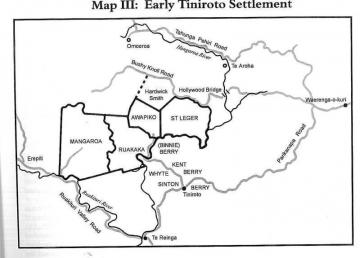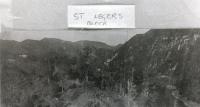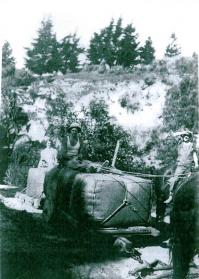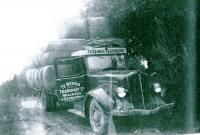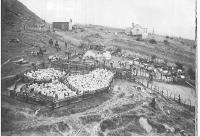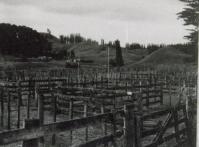Home-Tiniroto through the looking glass
- Team Tiniroto
- Research process
- Learning outcomes
- Moa at Tiniroto
- Legend of Whakapunake
- The legend of our rivers
- Te Kooti in Tiniroto
- Farming history in Tiniroto
- Schools in Tiniroto
- The history of the Tiniroto Tavern
- The Army in Tiniroto
- Communication over the years
- Ruakaka Station
- Earthquakes in Tiniroto District
- Fighting fires
- Community Hall
- Te Roto
- Te Awa
- Native birds
- Our maunga
- Tiniroto landscapes
- Remembered for?
- References and acknowledgements
Farming history in Tiniroto
What did the farming used to look like?
This map shows the early farm boundaries in Tiniroto and the light grey lines show where the roads used to go (note that you had to go down the Parikinapa Road to get to Waerenga-O-Kuri!)
The land would have looked like the Te Urewera native forest does still today.
Before the bush was cut or burnt, it looked like this picture of St Leger.
Why did people start farming here?
The first settlers came to Tiniroto in 1868 when the land was covered with bush. People came to this isolated place because it was fertile and cheap. To clear the land it must have been hard because the tools that cleared the bush were very simple. There weren’t the machines we have today like bulldozers and chainsaws. Imagine cutting a massive tree down with an axe. That must have been a long day hacking at one tree!
I spoke to local farmer Mr Kent whose family has been farming in Tiniroto since the early days.
“I’m pretty sure the biggest change would have been the fact that fences were put up. In the early days, farms only had a couple of paddocks. Now there are much smaller paddocks, and you can do rotational grazing.
Also, bulldozers have put in tracks. In the old days everything was made by a horse with a plough – which took ages. They would bring in a bucket like on a front end loader and pull it behind the horse to make tracks etc. Farms now have more vehicles like motorbikes and so on to do the work the horses and men used to do.
The majority of early settlers, were Englishmen who came out with their own breeds of sheep or cattle. There were no choices in NZ, you just got what the Englishmen bought out by boat. Then New Zealanders started cross breeding. If someone liked a lot of wool they cross-bred to get lots of wool.
Biddy-bid was a really bad thing in those days. It would stick to sheep’s face and they would be blind and couldn’t see. The biddy-bids also ruined the wool and buyers didn’t want it. There was no way of getting the biddy-bids off! You had to shear them off. The Matawai area was really bad, quite often I would have to get off my horse, and cut the wool out of their eyes so they could see where they were going, then carry on. So in those areas they would breed to get a clean face sheep like Perendale or Cheviots."
Fertilizer
When the fertilizer was put on it made more grass, means more stock, means more money, means more farming equipment, means more fences means, more stock. Through this cycle farming in Tiniroto has prospered over the years.
The first known aerial application of agricultural materials was by John Chaytor, who in 1906 spread seed over a swamped valley floor in Wairoa.
By the end of 1949 there were five topdressing firms; Airwork had five Tiger Moths, James Aviation three, Aircraft Services three, Gisborne Aerial topdressing (which was to become Field Air).
Tiniroto would have been one of the early districts to be serviced by aerial topdressing because they had Gisborne and Wairoa both as pioneer fertilizer companies.
Mr Kent told me that
“In around about 1937 they started bringing super phosphate into Tiniroto. It came in big bags that couldn’t be lifted. They used to sow by hand! They made bags that they could carry on their fronts and would go out and throw it on the land by hand. To get it to the paddocks they would pull it out on sleds behind the horses. Mr Tahi Niania used to have a gang and they would go around Tiniroto sowing the paddocks (usually only the closest to the house). They were so good that Mr Kent got Mr Nianias gang to go all the way to Matawai.
Mr Kent took part when they first started spreading fertilizer with aeroplanes which were Tiger Moths in those days. They would have to get the plane beside a bank and then pour the super into the hopper by hand. It was a big job to do that”.
Mr Kent told us his first ride in a plane was when he had to get in the hopper (where they put the fertilizer) and flew from one airstrip to the next one. He wasn’t sure how much he enjoyed that trip!
Local fertilizer company Field Air's logo is a strangled goose. According to legend, a hungry Field Air pilot flying between airstrips saw a single goose which looked like dinner. After a few tricky manoeuvres he managed to fly beside it and get it, he was watched by local farmers and so came the idea for the logo.
The oldest buildings that still exist today in Tiniroto would be the old Raukura woolshed and the one at Clarkes.
I also spoke to local farmer Mrs Hamilton:
“Hugh St Leger was a significant part of the history of the early days. He owned a farm in Ireland called Doneraile before he became Lord Doneraile and came out New Zealand (Doneraile Park is actually named after him). His first property was made up of the four farms we know as Mangaroa, Ruakaka, Awapiko and St Leger today. In the early days, the government helped people that came back from war get into farming by giving them land and then letting them pay it back as they earned money. Many of these early farms in the Tiniroto area still carry the same names today. I believe that Charlie Gordon was one of the first farmers in Tiniroto and he farmed Mahaanui Station”.
I discovered that the farmland went through a major transformation due to the application of fertilizer and new grass types. Farming today in Tiniroto is still very successful.
This is the story of why the trees you see in Tiniroto today are in a straight line.
There used to be a big sheep sale yard here in Tiniroto. Due to falling stock numbers and ease of transport that came with improvements to the roads and technology, it was dismantled in
early 1980.
By Hamish

